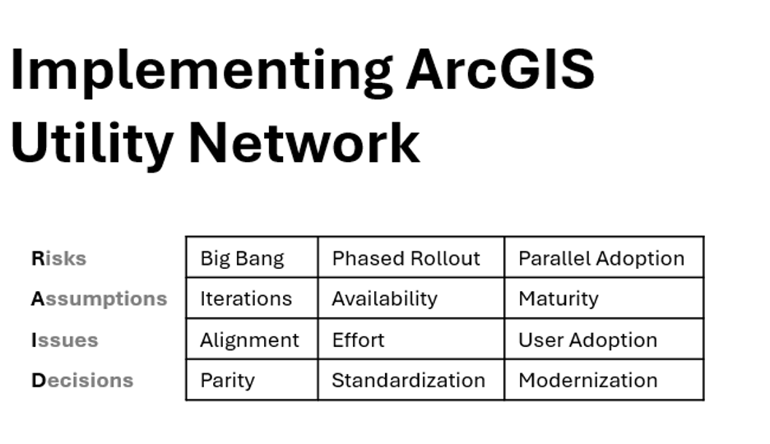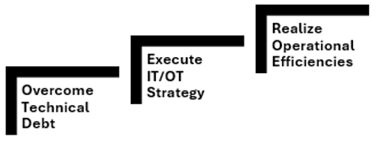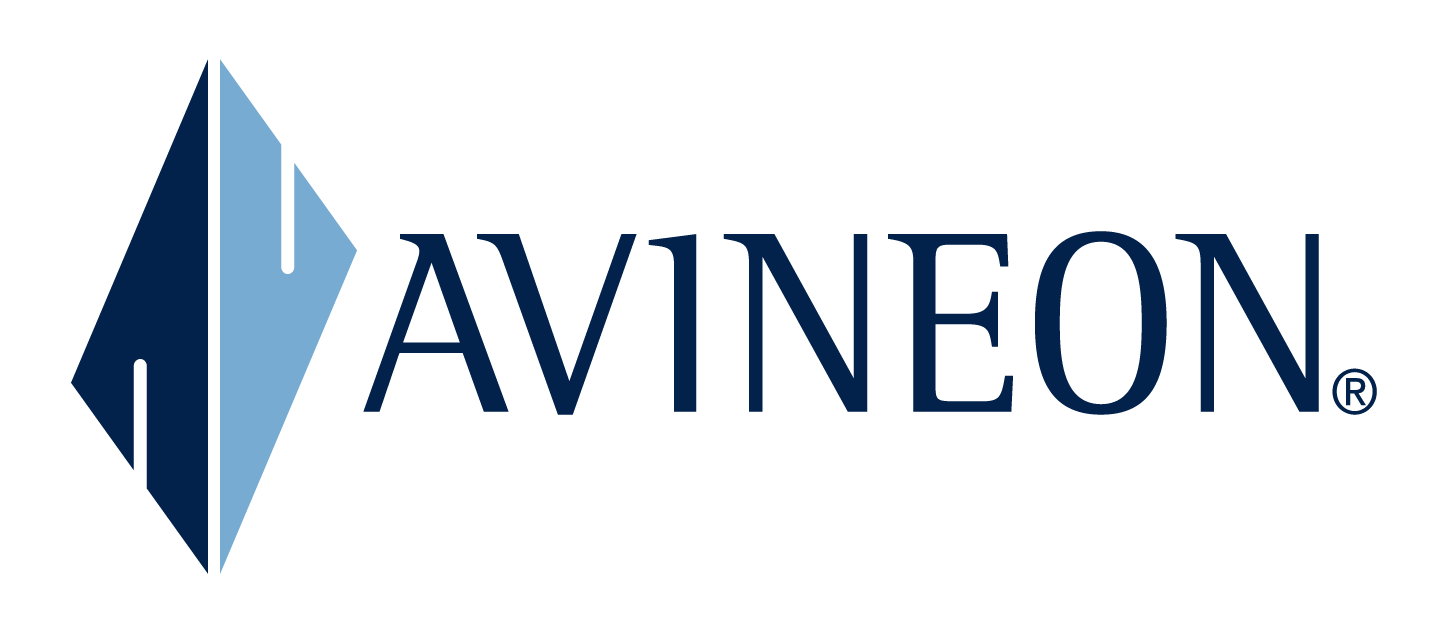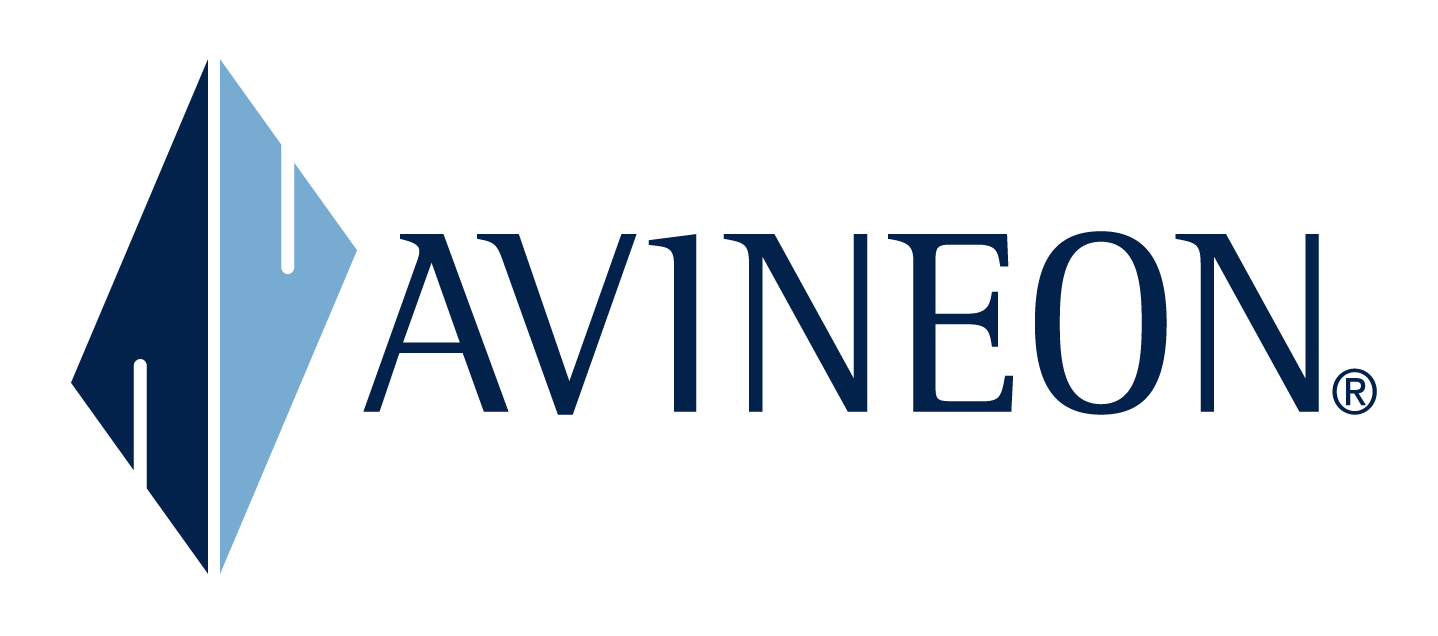The article is for Business/IT/ICT leaders (Supervisors, Managers, Directors, VPs, and CIOs), staff (Architects, Specialists, and Analysts), and IT PMO personnel at electric, gas, water, architecture, engineering, and telecommunication companies engaged in modernizing GIS using ArcGIS Utility Network (UN) from Esri.
This article highlights the business mission to address when implementing ArcGIS platform capabilities, extended software from Esri partners, or even conducting readiness assessments.
The article starts with an overview of goals and resulting outcomes, followed by a review of risks (R), assumptions (A), issues (I), and decisions (D), and a conclusion with twenty-eight focus areas to maximize return on investment.

Maximizing Return on Investment
Goals and Outcomes

Aspirations Ladder
Goals
The goals to consider are:
- Overcome technical debt by transitioning from 32-bit computing to a 64-bit platform for web and mobile-first capabilities
- Execute enterprise IT/OT strategy to roll out cloud and hybrid architectures for streamlining data flows and modernizing upstream and downstream integrations
- Realize operational efficiencies by re-engineering business processes, workflows, and use cases by leveraging new capabilities in the UN
Outcomes
The resulting outcomes, when planned, prioritized, and executed effectively, will result in improvements with:
- Accessibility
- Productivity
- Planning, designing, and operating infrastructure networks
The granular definition of these goals and outcomes at the user, use case, and department levels is essential to maximizing the return on investment.
Risks
![]()
Modernization Strategies
The selection of a modernization strategy plays a pivotal role in mitigating overall risk and maximizing the return on investment, as described below:
- The Big Bang strategy calls for a single cutover event to transition users and dependent systems from legacy databases, apps, jobs, and integrations to the replacing architecture. This strategy carries very high risk if chosen for heavily integrated systems.
- The Phased Rollout strategy allows one to release a minimal viable product (MVP) with multiple soft Go-Live and full Go-Live events organized into phases. The risk level is moderate, and dress rehearsals for carefully planned maneuvers are required.
- The Parallel Adoption strategy allows end users to use the legacy and modernized systems with full capabilities simultaneously for prolonged durations. While this is advantageous for end users, the infrastructure, project, and IT operational costs to realize such parallelism are high. The risk level is low for both Business and IT stakeholders.
Assumptions
![]()
Agile Methodology
The assumptions on the number of iterations, staff availability, and the criteria for assessing the solution's maturity for cutover directly impact the triple constraints—schedule, scope, and cost—and thus the return on investment.
- Iterations provide the opportunity to evolve the data model design, data migration rules, application configuration, application customizations, and data flows into integrated systems. If the rightsizing of these iterations by phases (design, build, hardening, cutover, etc.) is assumed incorrectly, it has a detrimental impact on the goals and outcomes.
- Availability of key staff members varies due to changing work demands from job and project responsibilities. This is further complicated when staff is involved in multiple projects and pulled into emergency events such as storm responses. Regarding infrastructure, the patching activities (OS, DB, apps, security, services, middleware, etc.) impact the availability of the infrastructure beyond the five-day x eight-hour window for project activities.
- Maturity is a grey area between objectivity and subjectivity regarding application functionality, data readiness, map products, accuracy, analytics, user experience, etc. The insight to make assumptions that can govern the entry/exit criteria for these maturity gates and the foresight to make necessary adjustments along the journey are essential to realizing the goals and outcomes.
Issues
![]()
Scope Management
The consensus between stakeholders, perception of effort, and user engagement is critical to achieving the goals and outcomes and will require the following:
- Aligning expectations and mindset with the system of record, data fidelity, distributed maintenance, data governance, online/paper map products, and desktop/web/mobile capabilities between Business and IT stakeholders avoids the time lost in disposing of issues and defects.
- Effort estimates are often limited to design, build, and testing tasks. The shift towards recognizing and planning adequate effort, essential for proactive design reviews and build validations, minimizes the time lost in reactive issue management.
- User adoption is organic and ineffective when limited to communications and training classes. It requires recognizing motivating factors, involvement, and education, fostering a high degree of engagement, and clearly understanding the guardrails (goals and outcomes) to prioritize the issues that drive success.
Decisions
![]()
Options Analysis
The implementation of the UN provides many opportunities to maximize outcomes. A methodic process that offers an opportunity for end user representatives and leadership on both Business and IT is essential to arrive at decisions collaboratively:
- Parity to ensure successful practices stay the same.
- Standardization to normalize designs, implement foundation data models, and adopt industry best practices.
- Modernization by going after opportunities that provide operational efficiencies.
These decisions affect the work and interdependencies between data models, data, application functionality, integrations, scheduled jobs, reports, maps, dashboards, analytics, etc., to achieve the digital twin of complex infrastructure networks.
Conclusion
RAID is not a one-time activity. The typical program management, project management, and agile process are essential but require a robust business mission to deliver measurable outcomes.
Facilitating a continuous process to manage risks, assumptions, issues, and decisions with representation from Business, IT, and organizational leadership is vital to planning, seizing opportunities, and prioritizing resources to achieve goals for intended outcomes.
In conclusion, the following table lists twenty-eight focus areas to maximize the return on investment:

Focus Areas for RAID Analysis
Avineon, a leader in spatial intelligence, can help to assist you in your journey. We have a rich history as an Esri Partner for over 20 years, and we are experienced in delivering a complete suite of geospatial products and services to our clients in numerous industries, including utilities and local, state, and federal government agencies.



